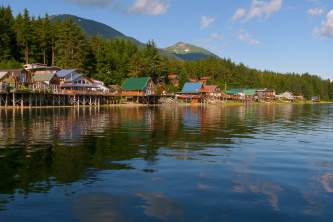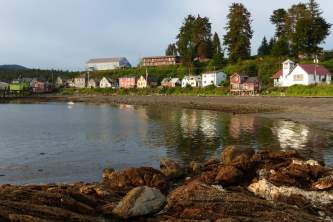Connecting With Angoon's Tlingit Culture
Angoon has been called the “stronghold of the Tlingit culture,” and its residents proudly uphold their heritage through language, stories, and traditional gatherings. You won't find any scheduled "shows" of Tlingit culture here. It's embedded in everyday life, and can be experienced just by talking with local residents.
Many of the people you will meet while in town are members of the Tlingit tribe, which has been in this area for more than 1,000 years. A misunderstanding in 1882 led to the U.S. Navy’s bombardment of the defenseless village, resulting in the destruction of homes, much of the winter food stores, and all but one canoe. While the community survived through much hardship, this event is still very much a part of the collective memory of Angoon’s residents.
The Tlingit culture is very much a part of day-to-day activities, special potlatches and community celebrations. Art and family structures are shaped by the Raven and Eagle clan designations that have existed for generations. You can see many traditional clan houses in a stroll along Aanya Street and Beaver Trail Road.
You might also find residents pursuing various subsistence activities: fishing, gathering and drying seaweed, picking berries, or searching the rocks at low tide for clams and gumboot. This large, spongy chiton can be prepared in many ways, even pickled. If offered, give it a try! There’s a good chance you won’t find it on the menu at your hometown restaurant, so take advantage.
Other ways to connect with Tlingit culture:
- Look for locally handcrafted arts like carvings and beading at the general store. Lodges will sometimes bring in local artisans for demonstrations and you can typically purchase items then as well.
- Historians have been studying Angoon and its clan houses for a number of years. Call the Angoon City offices or Angoon Tribal offices ahead of your visit if you’d like to see artifacts or learn details of the existing clanhouses and their decorations. Some artifacts at the local high school are re-appropriated items that have come back to Angoon after decades in other places. The stories of how they were lost and welcomed back are both fascinating and moving.
- When heading back to Juneau, make time for a visit to the new Walter J. Soboleff Building. This center, dedicated to the sharing the study of Tlingit, Haida and Tsimshian cultures, was named for Soboleff, who lived in Angoon just a few decades after it had been bombarded. Soboleff lived to be 102 and was an important Tlingit culture bearer.




